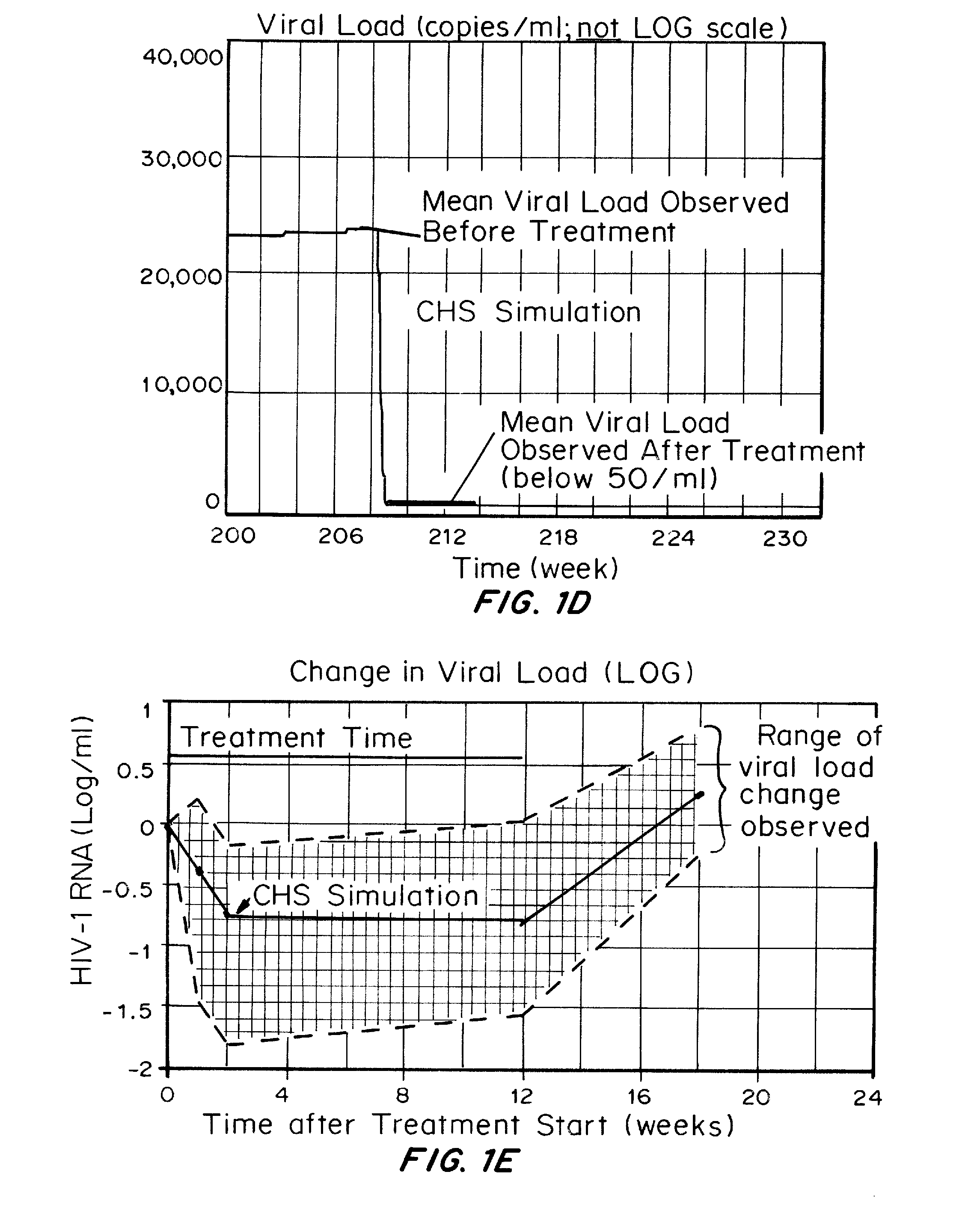Methods and compositions for treatment of HIV infection
a technology for hiv infection and composition, applied in the field of latent hiv infection treatment, can solve problems such as the number of cells, and achieve the effect of reducing viral load
- Summary
- Abstract
- Description
- Claims
- Application Information
AI Technical Summary
Benefits of technology
Problems solved by technology
Method used
Image
Examples
example 1
Simulation of HIV infection Treatment Outcome and Correlation with Multiple Clinical Trials
[0202]A computer model of the human immune system has been developed which can accurately simulate the effect on the immune system and clinical factors of HIV infection and clinical treatments of HIV infection.
[0203]The model has been validated by inputting the drugs, dosages, and dosing regimens as well as patients to be treated, for drugs in which the clinical outcomes have been described in the literature. The results obtained with the computer model, which is not based on input of the clinical trial results to be validated, demonstrate that the treatments using reverse transcriptase inhibitors do not result in elimination of HIV reservoirs, as shown by a rapid rise in blood viral load following cessation of drug treatment.
[0204]Seven active HIV drug trials were modeled based on patients being treated, drugs, dosages, and treatment regimens. Results of actual outcomes compared to simulated ...
example 2
Simulated Treatment to Hinder CD4 T Cell Infection; Force Latently Infected Cells to Produce and Present HIV; and Push a Stronger CD8 T Cell Response to HIV
[0234]Method of Treatment
[0235]Treatment simulation was performed to target three points at the same time to hinder CD4 T cell infection; force latently infected cells to produce and present HIV; and push a stronger CD8 T cell response to HIV. In this simulation, new infections are held in check directly (as with a CCR5 inhibitor), latent cells are pushed out via activation (such as with a histone deacetylase inhibitors), and the CD8 T cell response is magnified (as IL-15 might accomplish), for example, by administering Maraviroc, vorinostat and IL-15 using standard dosing: Maraviroc at 600 mg / 2× / daily, Vornisotat at 400 mg daily.
[0236]Under the specific treatment protocol tested, new infections are slowed by hindering CD4 T cell activation, therefore reducing the target population for HIV infection. Latently infected cells are f...
example 3
Simulation of Combination Treatment to Reduce HIV Infection of CD4+T Cells, Drives HIV and Associated Antigen Presentation from Latently Infected Cells, and Prevents Viral Replication
[0240]Method of Treatment
[0241]This example describes simulations using the model of a treatment strategy that uses two targets (“levers”) concurrently, then adds a third, HAART, to clear the rest of the HIV. The initial targets are to reduce HIV infection of CD4+T cells and to drive HIV and associated antigen presentation from latently infected cells. The first effect can be accomplished with, for example, a CCR5 inhibitor such as Maraviroc. The second effect can be accomplished with, for example, a histone deacetylase inhibitors such as Vorinostat. All simulations using Vorinostat assume 400 mg, once daily and Maraviroc at 600 mg / 2× / daily.
[0242]Results
[0243]In the initial simulation runs with just the first two treatments, HIV is not cleared. The results shown in FIGS. 4 and 5 are for the treatment pr...
PUM
| Property | Measurement | Unit |
|---|---|---|
| time | aaaaa | aaaaa |
| time | aaaaa | aaaaa |
| time | aaaaa | aaaaa |
Abstract
Description
Claims
Application Information
 Login to View More
Login to View More - R&D
- Intellectual Property
- Life Sciences
- Materials
- Tech Scout
- Unparalleled Data Quality
- Higher Quality Content
- 60% Fewer Hallucinations
Browse by: Latest US Patents, China's latest patents, Technical Efficacy Thesaurus, Application Domain, Technology Topic, Popular Technical Reports.
© 2025 PatSnap. All rights reserved.Legal|Privacy policy|Modern Slavery Act Transparency Statement|Sitemap|About US| Contact US: help@patsnap.com



